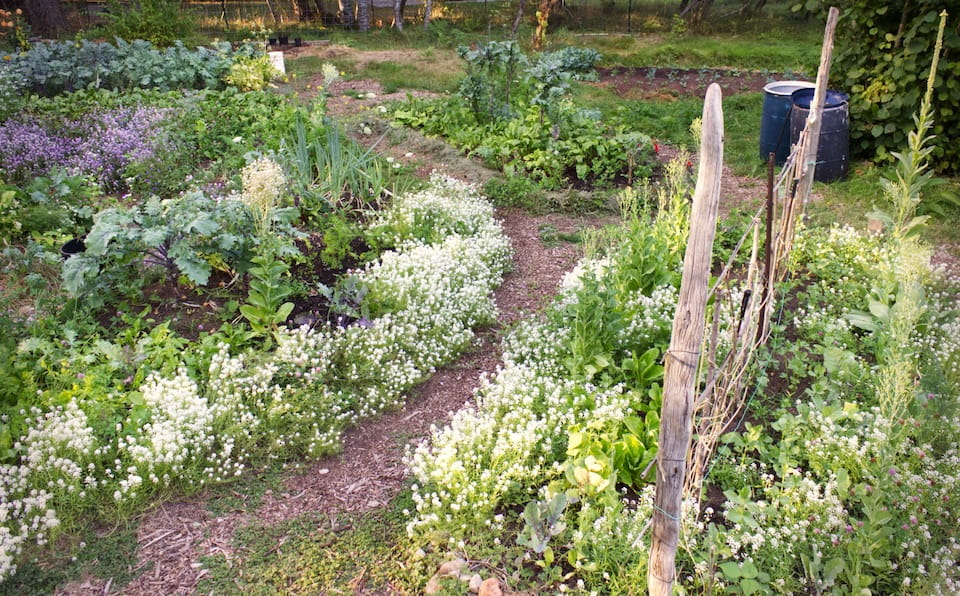Also known as sweet alyssum or Lobularia maritima, alyssum belongs to the Brassicaceae family, which includes cabbage, mustard, and broccoli. It comprises annual and perennial herbaceous plants or small shrubs with oblong-oval leaves that can grow up to 10–100 cm tall. Alyssum flowers are typically small and white or yellow but can also be pink or purple, and they group in small terminal clusters. The genus also includes species like Aurinia saxatilis (common rockery plant).
Derived from the Greek words “a” meaning “without” and “lyssum” referring to “rage” or “frenzy,” it is noted in some traditional medicinal as a “cure for madness.” In some cultural traditions, it is also said to symbolize purity, humility, and grace. 1
While a common garden plant for its beauty, it holds culinary uses as well. The flower’s sweet fragrance and peppery taste make it a seasonal garnish to salads, desserts or appetizers, enhancing both the taste and visual appeal of dishes.2
Alyssum’s Ecological Role
Native to the Mediterranean, including Southern Europe, Northern Africa, and the Canary Islands, the early history of its cultivation traces back to 16th-century Spain. Lobularia maritima was hybridized and developed in the 1800s.3
Alyssum’s clusters of small, fragrant flowers have long-graced gardens, balconies, and window boxes. Its distinct sweet, honey-like fragrance and nectar-rich flowers provide a vital food source for many pollinators, including honeybees, bumblebees, and solitary bees who collect pollen and nectar to sustain their colonies and offspring.
Its compact growth and bountiful closely clustered flowers grant efficient foraging opportunities. Along with bees, butterflies and hoverflies also regularly flit from flower to flower, dropping pollen bundles along their way. Ladybugs and lacewings are also frequent visitors and can assist with pest control. 4
The structure of alyssum’s flowers makes them easily accessible to a wide range of pollinators. Their shallow nectar tubes and accessible pollen allow even very small insects to partake. This maximizes the diversity of pollinator species in a given area. With such a long blooming season, it is one of the most reliable pollinator suppliers, and in milder climates, it can last late into fall. In my own garden, it provides nectar from May to late October.
Alyssum as a Cover Crop:
Able to withstand poor soils and some drought, its low-growing habit and prolific white to purple blooms have made it a popular choice for ground cover, edging, and container growing. Beyond its decorative role, when planted densely, alyssum forms a mat that suppresses weed growth, conserves soil moisture, and prevents erosion. Planted between rows of crops or in fallow fields, it makes for a resilient fragrant living mulch. Once it dies back in late fall the remaining mass decays, releasing nutrients back into the soil.
While growing its extensive root system improves soil structure, and enhances nutrient cycling. It promotes microbial activity, thereby enriching the soil for subsequent crops.
Alyssum has some allopathic properties, releasing chemicals that inhibit the growth of certain weeds and pests.5 Some examples of alyssum’s allelopathic properties include inhibiting common weed species like lambs-quarters, pigweed, dandelion, and Canada thistle.6
Beyond pollinators, its fragrant blooms attract beneficial insects such as predatory beetles and parasitic wasps, which help control pest populations naturally.
Considerations:
While Alyssum offers numerous benefits in certain climates or soil conditions, it can become invasive, spreading each season and outcompeting native vegetation. Monitoring and management are necessary to keep it within its intended boundaries. In regions like California and Hawaii, alyssum has become an invasive species, disrupting natural ecosystems by crowding out native foliage.7
Additionally, Alyssum may attract certain pests or diseases that could pose challenges to neighbouring crops. Integrated pest management strategies, such as crop rotation and companion planting, can help mitigate these risks and maintain ecological balance. It is, fortunately, extremely easy to pull out should you want to edge it back.
In my own garden, alyssum has vigorously self-seeded, and each year emerges to frame my garden bed borders. Because It meets winter frost each year, it can not go far beyond its intended bounds. It invites many pollinators from May to October, and its sweet scent in summertime just adds to the garden’s allure. While I am happy to see it swarm with buzzing insects, it is also great to know the roots are helping rejuvenate the tired soil beneath.

Alyssum Benefits
Pollinator-friendly: The long blooming period attracts butterflies. bees and hoverflies.
Erosion Control: Alyssum forms a living mulch over the soil surface, preventing erosion and preserving precious topsoil
Soil enrichment: As they penetrate the ground, alyssum roots, loosen compacted soil. It’s end of the season decomposition releases organic matter back into the soil
Weed suppression: The dense foliage of alyssum out-competes with weeds for sunlight, space, and nutrients, suppressing their growth, and reducing the need for herbicides.
Caution: Alyssum can be invasive in some regions if unmanaged and allowed to self-seed past intended boundaries. Check with your environmental authorities to see if it is on the list where you are.
While many do consume alyssum as a garnish with no issue other people with special skin sensitivity can have an allergic reaction to handling it.8

Alyssum Companion Plants:
Lobelia, snapdragons, pansies, violas, roses, camellias, crepe myrtle shrubs, lavender, rosemary, sage, thyme, iris, daylilies, shasta daisies, guara, salvia, penstemon, petunias, four o’clock flowers, zinnias, garden heliotrope, coral bells, beans, peas, tomatoes, peppers, basil, mint, pole beans, lettuce squash, and marigolds. 9

- https://floristempire.com/guides/alyssum-flower-meaning/ ↩︎
- https://specialtyproduce.com/produce/White_Alyssum_Flowers_18035.php ↩︎
- https://ibot.sav.sk/usr/Karol/docs/PDF_files/1300214_Lihova_4.pdf ↩︎
- https://www.ncbi.nlm.nih.gov/pmc/articles/PMC7160144/ ↩︎
- https://www.jstor.org/stable/3988570 ↩︎
- https://www.dal.ca/faculty/agriculture/oacc/en-home/resources/pest-management/weed-management/organic-weed-mgmt-resources/weeds-allelopathy.html ↩︎
- https://specialtyproduce.com/produce/White_Alyssum_Flowers_18035.php ↩︎
- https://www.floralencounters.com/Seeds/seed_detail.jsp?grow=plants&productid=87661 ↩︎

